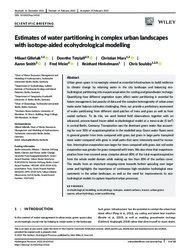Estimates of water partitioning in complex urban landscapes with isotope‐aided ecohydrological modelling
Hinkelmann, Reinhard
DOI: https://doi.org/10.1002/hyp.14532
Persistent URL: http://resolver.sub.uni-goettingen.de/purl?gldocs-11858/9946
Persistent URL: http://resolver.sub.uni-goettingen.de/purl?gldocs-11858/9946
Gillefalk, Mikael; Tetzlaff, Doerthe; Marx, Christian; Smith, Aaron; Meier, Fred; Hinkelmann, Reinhard; Soulsby, Chris, 2022: Estimates of water partitioning in complex urban landscapes with isotope‐aided ecohydrological modelling. In: Hydrological Processes, Band 36, 3, DOI: 10.1002/hyp.14532.
 |
Dokument öffnen: |
Urban green space is increasingly viewed as essential infrastructure to build resilience to climate change by retaining water in the city landscape and balancing ecohydrological partitioning into evapotranspiration for cooling and groundwater recharge. Quantifying how different vegetation types affect water partitioning is essential for future management, but paucity of data and the complex heterogeneity of urban areas make water balance estimates challenging. Here, we provide a preliminary assessment of water partitioning from different sized patches of trees and grass as well as from sealed surfaces. To do this, we used limited field observations together with an advanced, process‐based tracer‐aided ecohydrological model at a meso‐scale (5 km2) in central Berlin, Germany. Transpiration was the dominant green water flux accounting for over 50% of evapotranspiration in the modelled area. Green water fluxes were in general greater from trees compared with grass, but grass in large parks transpired more water compared with grass in small parks that were intensively used for recreation. Interception evaporation was larger for trees compared with grass, but soil water evaporation was greater for grass compared with trees. We also show that evapotranspiration from tree‐covered areas comprise almost 80% of the total evapotranspiration from the whole model domain while making up less than 30% of the surface cover. The results form an important stepping‐stone towards further upscaling over larger areas and highlights the importance of continuous high‐resolution hydrological measurements in the urban landscape, as well as the need for improvements to ecohydrological models to capture important urban processes.
Statistik:
ZugriffsstatistikSammlung:
- Geographie, Hydrologie [454]
Schlagworte:
ecohydrological modellingecohydrology
isotopes
sealed surfaces
tracers
urban green spaces
urban hydrology
water partitioning
This is an open access article under the terms of the Creative Commons Attribution License, which permits use, distribution and reproduction in any medium, provided the original work is properly cited.

